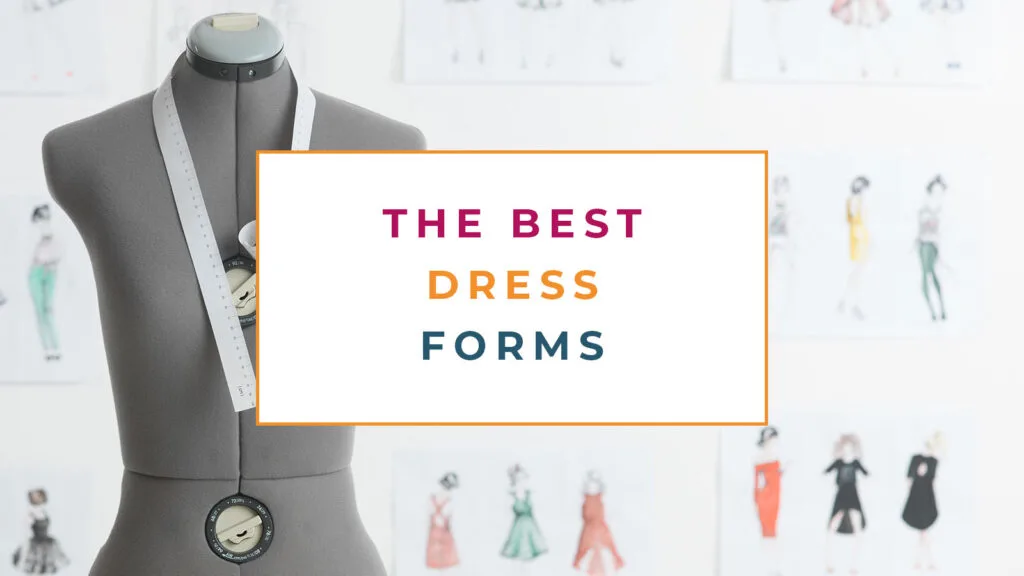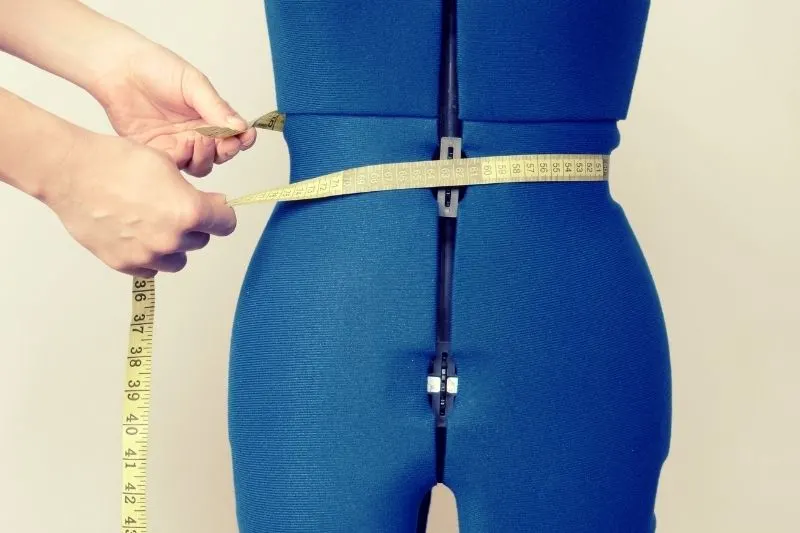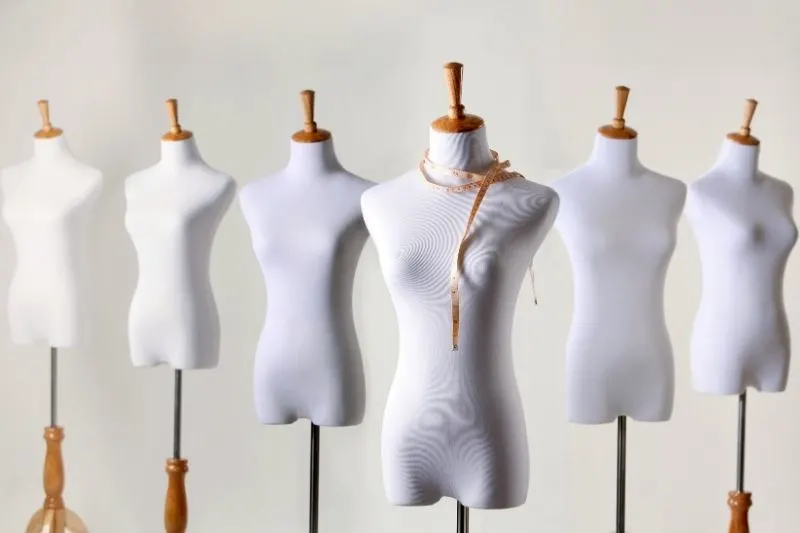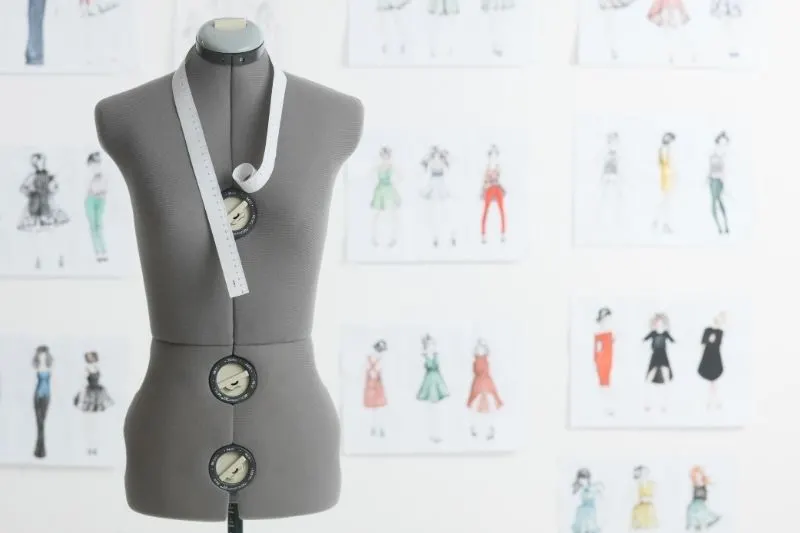If you make your own clothes, a dress form will be handy for fitting garments as you make them and for draping and developing patterns. Choosing the best dress form for your needs is where it gets tricky. They can be expensive clothes hanging devices if you choose the wrong dress form for your needs – and after hearing from many sewers who have said that they don’t end up using theirs, I wrote up this guide on choosing the right one for you.
I’ll share with you the different types of dress forms and things to consider before buying one for yourself.
I also created a video covering this topic a while ago, so I have linked it at the bottom of this post for those who prefer to watch.
Finally, if you’re looking for a dress form specifically for men, I suggest you read through this post first for an overview and then read my post on the best male dress forms for men.

Dress Form vs Mannequin vs Tailors Dummy
Let’s start by clearing up the different terms that are used for the same item. I refer to my dress form as a dress stand. It may be a British thing, but that is what they were called when I studied for my fashion design degree.
While that term is less widely used outside of fashion design, three that are frequently used to describe the same thing are:
- Dress form
- Mannequin
- Tailors dummy
So how do they differ?
Dress Form
This is the standard term used by home sewers and fashion designers alike. The standard form is a torso and it includes the hips and the upper leg area, though usually without the crotch separation.
Mannequin
A mannequin is usually a much more stylised version of a dress form, and is used for display purposes. They may be torso, legs, or full body, and you’ve doubtless seen body part mannequins too, from hands to display rings and bracelets to heads for displaying hats.
Tailors Dummy
A tailor’s dummy is much like a dress form (indeed people do use the two interchangeably in the home sewing community) but a tailor’s dummy was originally one used by traditional tailors!
6 Things To Consider When Buying A Dress Form
When you’re thinking of buying a dress form, you need to consider the uses that you hope to get from one. Without thinking about how you plan to use a dress form, you’ll likely end up buying one that isn’t right for your needs, and will then feel frustrated.
Here are six things to consider when assessing the suitability of a dress form:
- Adjustability
- Portability
- Shape
- Size
- Type
- Use
Adjustability
A dress form with adjustable options is great if you’re a dressmaker planning to create clothes for people of different sizes, or if you are a home sewer and anticipate losing or gaining some weight. Adjustable dress forms allow the girth of the body to expand or contract in different areas of the body and the length of the torso can sometimes be lengthened or shortened, depending on the particular model.
This type of form is great for differently shaped bodies as well, as we’re more able to control the individual measurements:
- Bust
- Waist
- Hips
- Torso length
Further down I’ll be sharing the adjustable dress form that I found and currently use!
Portability
If you plan to use your dress outside of your dedicated space, then you’ll want to consider how portable it is.
I have a professional Kennett and Lindsell dress form which I invested in (£1k+) while at university. It is a professional dress form and quite heavy because of the way it was constructed.
Usually, adjustable dressmaker forms and display forms are more portable, but they both serve different purposes.
Shape
Every human body is different when it comes to proportions and shape and a dress stand will need to be tailored to your needs based upon your body shape. You can pad out a form using fabulous fit pads or – like me, an old bra and some wadding – to get a more ‘you’ size form.
As well as body shape there’s also gender and age to consider: male, female and child being the obvious.
Size

Dress forms can be a fixed size non-adjustable form, or have an adjustable size range, and it is essential that you consider the size that you need. There’s nothing worse than buying a dress form and realizing the size is inappropriate. Be sure to take your body measurements and use these as a guide when researching your options and buying!
5 Types of Dress Forms

Now I’ve covered the six considerations, let’s now dig into the five types of dress form available to you!
- Adjustable
- Bifurcated
- Custom
- Display
- Professional
There is also the duct tape dress form. While this is an option for people who are not yet ready to invest in a manufactured dress form, there are often inconsistencies when making your own duct tape version. If you’d like to learn how to make your own duct tape form, this step by step tutorial from Burda will help!
Adjustable Dress Forms

An adjustable form provides a lot of flexibility and can be a good choice accordingly. They often come with a tripod stand making the height adjustable, a slightly more realistic body shape than those offered by professional dress form manufacturers (Morplan, K&L and TSC Professional Dress Forms immediately spring to mind) and for that matter are also lighter than a pro form too, making it easier to move around your sewing room.
The sizing is adjusted with an adjustable dial to modify the body form to better suit the measurements you’re planning to use.
Bifurcated Dress Form
A bifurcated dress form has legs included, so it isn’t just the torso, but a full body form or a half body form featuring the waist down. This is great for anyone really serious about design – you’ll be able to design and fit trousers using a bifurcated dress form!
Custom Dress Form
A custom dress form is also known as a made to measure dressmakers dummy. They are typically not adjustable, and are created using your body measurements, either provided to the company yourself, or as part of being scanned. This is the best way to get a perfect fit when you’re designing and making your own clothes.
There are several companies that provide this kind of form, one of the newer ones being Beatrice Forms.
Display Dress Form
A display form is not a sewing mannequin, but is used to display garments instead. It is not possible to use pins on this type of dress form as there is no padding and they also come in specific set sizes, often with adjustable limbs making them great for designers who want to display garments in their design studio or in a store.
Professional Dress Form
A professional dress form is an investment for any fashion designer, and even more so for fashion students. You will have seen this type of dress form on the TV show Project Runway.
A professional form is created in a fixed size, often with a fiberglass interior form which is then covered with a very light layer of padding and tightly woven fabric shell. This makes it great for easy pinning!
I have a professional one from Kennett & Lindsell, and the dress form size is fixed at size 12, but there are many companies that now make professional forms – I’ll list them towards the end of this guide for those interested, but you can also learn more about dress forms for fashion design here.

Optional Add On’s For Dress Forms
Standard dress forms do not come with bells and whistles, but rather you will have to ‘add on’ the features you would like. Common add-ons include:
- Collapsible shoulders (on professional grade forms, my K&L has this)
- Optional arms (not generally available with the plastic moulded forms)
- Hem marker (more of a ‘gimmick’ for the sewing mannequins sold to sewists)
With all of the above covered let’s move on to the best dress forms that you can buy!
Note: Some of the links in this article are affiliate links. This means that I may receive a commission if you make a purchase, at no extra cost to you.
Best Dress Forms

I’m not at all surprised to see that the top three dress forms are actually adjustable forms, from the two biggest names in the sewing tools arena.
1. Dritz My Double Designer Adjustable Dress Form
This Dritz form comes in four sizes:
- Petite
- Small
- Medium
- Full figure
Due to this, you’re more likely to find the perfect size range for you and your body type! I say range as it is an adjustable form but it is also the most expensive option of the three I’m sharing here.
Let’s look at the sizings of this adjustable dress form in more detail!
Petite Size Double Designer
- Bust: 28″ – 35″ / 70cm – 87cm
- Waist: 23.5″ – 31″ / 59cm – 77cm
- Hips: 31″ – 38″ / 77cm – 95cm
- Neck: 14″ – 17″ / 35cm – 42cm
- Back length: 14″ – 16″ / 35cm – 40cm
- Shoulder: 13″ / 32.5cm
Small Size Double Designer
- Bust: 33″ – 41″ / 82cm – 102cm
- Waist: 26″ – 34″ / 65cm – 85cm
- Hips: 36″ – 44″ / 90cm – 110cm
- Neck: 15″ – 18″ / 38cm – 45cm
- Back length: 15″ – 17″ / 38cm – 42cm
- Shoulder: 14″ / 35cm
Medium Size Double Designer
- Bust: 39″ – 47″ / 98cm – 117cm
- Waist: 32″ – 40″ / 80cm – 100cm
- Hips: 41″ – 49″ / 103cm – 122cm
- Neck: 15″ – 18″ / 38cm – 45cm
- Back length: 15″ – 17″ / 38cm – 42cm
- Shoulder: 15.5″ / 38.5cm
Full Figure Size Double Designer
- Bust: 45.5″ – 53″ / 114cm – 132cm
- Waist: 39″ – 46″ / 98cm – 115cm
- Hips: 47″ – 54″ / 117.5cm – 135cm
- Neck: 15″ – 18″ / 38cm – 45cm
- Back length: 16″ – 18″ / 40cm – 45cm
- Shoulder: 16.5″ / 41cm
One thing to note is that the adjustable wheels on this Dritz are easier to turn and also has an ‘offset’ option for the pole, which allows you to also fit trousers too! As well as home sewists, this would make a good first dress form for someone at fashion school, for those times when you cannot get into the fashion studio to use the fit models and need to get an idea of size, fit, proportion and more.
You can learn more about the Full Figure dress forms from Dritz below:
- Petite size: US Amazon / UK Amazon
- Small size: US Amazon / UK Amazon
- Medium size: US Amazon / UK Amazon
- Full figure size: US Amazon / UK Amazon
2. Singer Adjustable Dress Forms
Singer is a much recognized sewing machine manufacturer; I have two of their very old hand cranked sewing machines and love them. And unlike some of their more modern sewing machines, their adjustable dress forms fair very well! This form comes in two sizes:
- Red: size 4 – 10 (US)
- Grey: size 10 – 18 (US)
Red (Size 4-10)
- Bust: 33″ – 40″ / 84cm – 101cm
- Waist: 25″ – 32″ / 64cm – 81cm
- Hip: 34″ – 41″ / 86cm – 104cm
- Neck: 13.5″ – 17″ / 34cm – 43cm
Gray (Size 10-18)
- Bust: 40″ – 46″ / 101cm – 116cm
- Waist: 31″ – 37″ / 78cm – 93cm
- Hip: 40″ – 46″ / 101cm – 117cm
- Neck: 13.75″ – 17″ / 35cm – 43cm
There are twelve dials to help you get your form as close to your perfect size as possible and the height is also adjustable but there are some complaints that the form is ‘boxier’ than the Dritz below. Learn more about the Singer dress forms here:
3. Dritz Sew You Adjustable Dress Form
Third on the list is the Dritz Sew You form, adjustable from a size 2 at its smallest, out to a size 18 when opened all the way. It is relatively flat chested though so not great for those with a larger bust measurement. This isn’t a bad thing however as we can easily pad out a bust with a bra – it’s what I have done with my adjustable dress form to accommodate my bust. The exact measurements for the small size are:
- Bust: 33″ – 40″
- Waist: 26″ – 33″
- Hips: 36″ – 42″
- Neck: 14″ – 17″
- Back waist length: 15″ – 17″
For the best results when adjusting this form, make sure to adjust the dials evenly as you go, rather than one at a time.
Learn more about this adjustable dress form on:
My New ‘Full Figure’ Dress Form
I recently bought myself a full figure adjustable dress form which matched my body type as closely as possible – definitely closer than the K&L form I had been using. It’s the ‘Celine Standard Plus Full Figure’ dress form from a company here in the Netherlands. The reason for my purchase was to teach my Drape & Contour students how to drape on an adjustable dress form, and not just a fixed size professional dress stand. In the photo below, it is the one on the far right.

As you can see, it is very different in size compared directly to my beloved professional dress form in the center. I opted for the ‘Celine’ because it was a sensible price point (on sale at €145), had an adjustable torso length (I have a longer than average upper body) and was similar to my body measurements meaning I could drape more clothing for myself.
I am personally not a fan of adjustable forms. The last one I owned was a blue Singer model, and while it did the job, I struggled with how different it was to work with compared to my K&Ls. But, as I said, if my draping students are learning to drape on a more affordable and adjustable dress form, it is only right that I teach them on one that is similar.
I’ve had some emails from my readers about this particular adjustable dress form so have included as much information as possible on similar models, as the ‘Celine’ only appears to be available in select European stores!
In the UK, you can get the Adjustoform ‘Olivia’ 8 part dress form from Amazon – it’s the same company that made my ‘Celine’. The large size looks exactly like my ‘Celine’ except the color of the cover is darker.
In the US, there is the Dritz Twin Fit Full Figure dress form which, looking at it and comparing it to my ‘Celine’, looks exactly the same and the price point is inline with what I paid in The Netherlands.
I had wanted the Dritz My Double Designer Full Figure dress form, which has the pole offset so better for draping trousers / pants, but I could not get it outside of the US and the cost of shipping to The Netherlands and the import duty made it a very silly price!
Non Adjustable Dress Forms
If you’re looking for a dress form that is a fixed size – not adjustable – you’ll be better off buying from a company that makes professional forms.
Those include:
- Alvanon
- Andy’s dress form
- Kennett & Lindsell
- Morplan
- PGM dress forms
- Royal dress Forms
- Wolfform
The above companies make professional dress forms with a variety of options including collapsible shoulders, a base plate and castors for a more stability over the tripod leg style and even attachable arms can be included too.
If you’re a fashion designer planning on a lot of drape and contour as part of your design process, one of the above brands would be a great choice, but note that second hand are always an option. Ebay is one location where I’ve seen Kennett & Lindsell and Morplan dress forms available at a reduced price.
Do check out my latest article on the best dress forms for fashion design afterwards also learn a little more.
For home sewers wanting to achieve a fabulous fit with their home sewn clothes, one of the above adjustable forms would be the best dress form for you to get started with.
There you have it. Let me know if you have any questions about dress forms – I love my current one and cannot wait to have a larger work space so I can add one or two more to my collection!
Of course, once you have a dress form, you’ll probably want to learn how to drape on a dress form which will help you create a basic bodice block!
How To Pick A Dress Form
Drape & Contour For Beginners
When you’ve chosen your dress form, do check out my online course Drape & Contour for Beginners. Suitable for beginners new to draping as well as anyone who has previously draped but needs a freshen up, this online course will teach you:
- How to drape a bodice block
- How to drape a skirt block
- How to contour a corset / bustier style top
- How to manipulate darts
- And much more!
You can learn more about Drape & Contour for Beginners here!


Daphne
Tuesday 7th of November 2023
Useful run down on various forms. Do you know of any that are not foam based? I want to steam, mould and press fabric on the form and need one that will cope with heat without distorting. Thank you, DvA
Eve Tokens
Tuesday 28th of November 2023
Hi Daphne! For the purposes of steaming, your main concern won't be the foam, but the base material, and the cheaper dress forms are generally plastic based. If you looked into K&L - I have two of their forms which have a fiber glass base and a very very find layer of foam between the base and the linen cover. That may be the best option for you!
BeBe
Friday 26th of May 2023
Thank you. I'm helping my 16-year-old granddaughter with an interest in sewing. Your articles have been helpful to both of us. I hope she sees fashion design in her future! Always challenging, but always interesting.
Sarah
Sunday 31st of July 2022
Hi Eve, this is very informative, thank you! I am considering purchasing an adjustable dress form because I have a long torso. Is the Dritz adjustable in torso length, or one of the others? After looking online I couldn't really tell specifically. I also have broad shoulders but I'm not sure an adjustable dress form can help with that. Thank you so much for this article.
Eve Tokens
Monday 1st of August 2022
Hi Sarah, thank you for the lovely feedback! I too have a long torso, which is why I bought an adjustable form. From the ones I reviewed, only the Dritz are adjustable in the length, by approximately 2" / 5cm. And in all honesty, I struggle with this amount, I could use 3" and with options to distribute that above the bust and at the waist. Sadly, that's probably never going to be something the manufacturers put into practice, so I have ended up padding it out to get a more realistic shaping for my body. I will be adding a tutorial to my YouTube this month showing the process, so if you do end up grabbing an adjustable, you can always follow along with that tutorial to make it more reflective of your body's shape! Best, Eve
Svonne Stickley
Monday 11th of July 2022
I don't know how I can drape on the Dritz My Double Designer Adjustable Dress Form because it doesn't let me stick pins into it.
Eve Tokens
Tuesday 12th of July 2022
Hi Svonne, please see my response yo your previous comment below. I do have a lesson on this inside my Drape & Contour course, but understand that you may not wish to purchase a course just for that information. So, I will create a photo tutorial tomorrow on the process of pinning on an adjustable dress form. I hope that will be helpful for you so that you can get started with draping!
Svonne Stickley
Monday 11th of July 2022
I don't know if you know but the Dritz My Double Designer Adjustable Dress Form does not have any padding that let you stick pins into it. It is just a thin piece of material over hard plastic. Very disappointing.
Eve Tokens
Tuesday 12th of July 2022
Hi Svonne! Yes, this is true of almost all adjustable dress forms unfortunately. They are cheaper because they have a plastic shell, with a felt like fabric on top. It means that pins cannot be 'stuck' into the dress form, but they can be manoeuvred so that they push into the fabric covering the way we would pin fabric pieces together. I know it isn't necessarily what you were hoping for, but the only dress forms that are softly padded that you can stick pins into are much more expensive - or made from polystyrene which very quickly distorts and is useless.